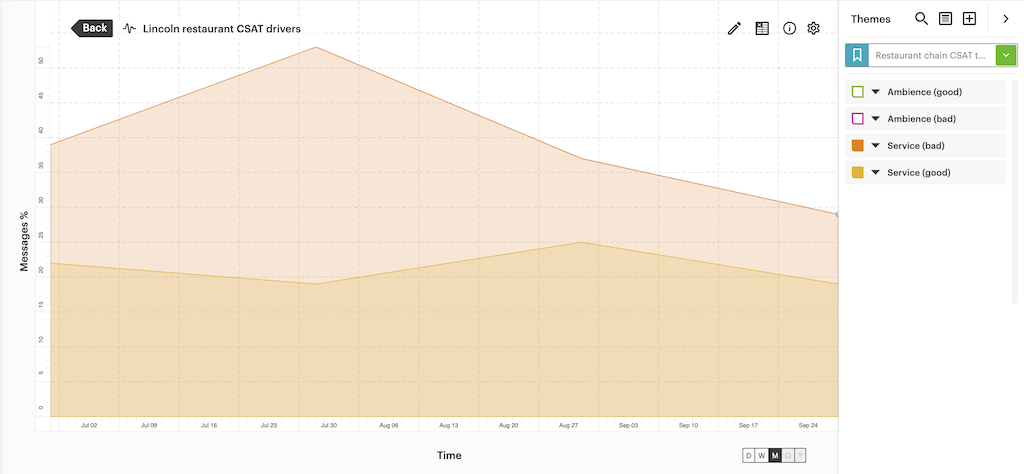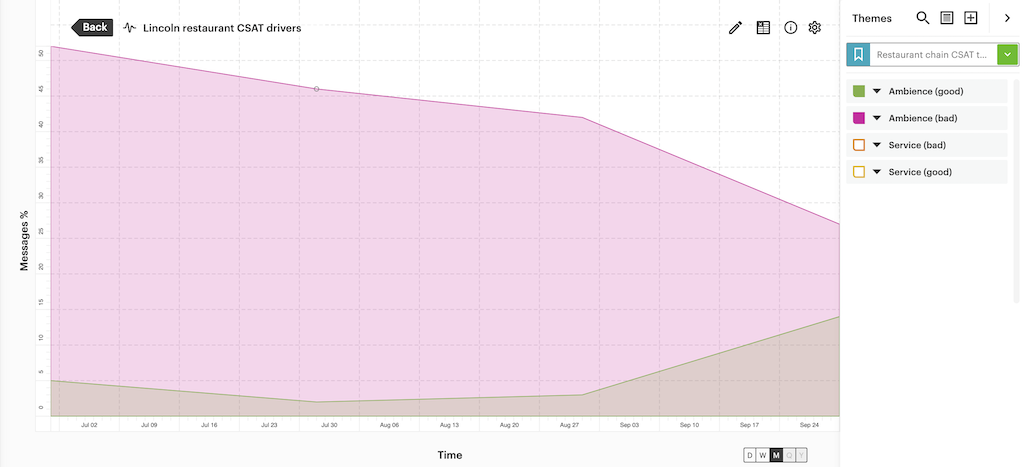Augmenting a restaurant CSAT survey program with text analytics

The restaurant sector is among the most competitive and challenging. Venues’ fierce struggle to survive and thrive has become more acute since the pandemic. Conducting detailed restaurant survey programs is a necessity to understand diners’ needs and keep them coming back for more.
For chains with venues across the country, collecting, analyzing and acting on restaurant feedback can be tricky. Delegating responsibility for survey feedback analysis to individual locations diminishes visibility for company-wide restaurant customer care teams.
However, collecting, analyzing and acting on feedback within one customer team is a huge undertaking. To extract actionable intelligence, restaurant customer care teams need the right CSAT survey analysis software.
With this in mind, a casual dining chain with outlets across America turned to Relative Insight. CSAT scores for its venues fluctuated wildly — but its customer care team struggled to pinpoint the factors behind this variance due to an overwhelming amount of restaurant feedback.
The team initially wanted to use the Relative Insight platform to analyze CSAT responses for its high-performing Oklahoma City outlet and its low-scoring eatery in Lincoln, Nebraska. The tool’s ability to get to the heart of what matters to customers turned this one-off project into a CSAT text analysis program.
Ambience & attentiveness are key customer satisfaction drivers
The company’s customer team wanted to identify the factors behind high and low customer satisfaction scores. Rather than manually reading thousands of responses for each location, the team used Relative Insight’s CSAT survey analysis software to identify differences in feedback for high and low-scoring restaurants.
This analysis highlighted two clear areas of differentiation relating to its Oklahoma City and Lincoln restaurants.
Attentive waiting staff enhance CSAT scores
The first area was related to the attentiveness and quality of service. At the chain’s Oklahoma City eatery, diners were 3.0x more likely to use words relating to ‘friendliness’ when talking about staff, including ‘friendly’, ‘inviting’ and ‘accommodating’. They were also infinitely more likely to describe servers as ‘attentive’, meaning this didn’t appear at all in reviews about the Lincoln outlet.
“I was blown away by the level of attentiveness shown by the waiting staff at this restaurant. From the moment we were seated, they made us feel like VIPs, anticipating our needs before we even had to ask. They were friendly, professional, and went out of their way to ensure we had a memorable dining experience.“
Conversely, people eating at the Lincoln restaurant criticized the service and attitude of its staff. They used the words ‘disinterest’, ‘indifferent’ and ‘inattentive’ infinitely more, while also describing the overall service as ‘chaotic’.
“The inattentiveness of staff at the restaurant was frustrating. Despite the dining area not being busy, it took a considerable amount of time for our orders to be taken and even longer for our food to arrive. Additionally, there was little follow-up or check-ins from the servers during our meal.“
Ambience and atmosphere make a huge difference to satisfaction
The second element that surfaced within the analysis was each location’s ambience. Restaurant survey participants for both eateries remarked upon the dining environment — for very different reasons.
Again, respondents’ feedback in Oklahoma City was overwhelmingly positive. They were 20.3x more likely to use positive descriptions of the ambience and atmosphere compared with Nebraska respondents. This group described the venue as ‘inviting’ 8.9x more, while also using words such as ‘cozy’, ‘comfortable’ and ‘relaxed’ to describe their experience.
“It’s a real gem! The ambience is warm and inviting, making it the perfect spot for a relaxed meal.“
The atmosphere and ambience at the Lincoln restaurant deters customers. There was an uneasiness to the atmosphere that deterred diners. Survey respondents were infinitely more likely to say they had ‘bad vibes’ and a negative ‘underlying feeling’ at the outlet. Restaurant feedback also featured the words ‘unwelcoming’ and ‘unpleasant’ infinitely more.
“My experience at the restaurant left much to be desired due to the bad vibe there. Despite the decent food, there was an underlying feeling of tension and discomfort in the atmosphere. It felt unwelcoming and offputting.“
Restaurant survey respondents were also unimpressed with its acoustics. Patrons complained that the venue was either too loud or too quiet. They were infinitely more likely to talk about the ‘noise level’, describing it as ‘excessive’ infinitely more and ‘quiet’ 5.9x more.
“There was an uncomfortably quiet atmosphere. The lack of background noise made it feel like every conversation could be overheard by neighboring tables.“
Restaurant customer care team defines key metrics to track
The results of this analysis surprised the restaurant chain’s customer care team. They had expected food quality to be the key driver of outlets’ CSAT scores. However, feedback for its Lincoln restaurant was 3.9x more likely to praise the food, despite it having an inferior CSAT score.
While service excellence was suspected to be a factor in customers’ ratings, the team didn’t believe it would have such an impact on customer scoring. They were even more surprised by the importance of ambience and atmosphere. Until this analysis, the team had not factored in its influence on CSAT scores.
Based on these findings, the team wanted to use Relative Insight’s CSAT survey analysis software to determine whether these factors applied to its entire estate of restaurants. To do this, they built Custom Themes within the Relative Insight platform based around service and ambience.
The team used words and phrases from restaurant feedback to build positive and negative variations on these themes. For example, the Custom Theme ‘good ambience’ included words such as ‘cozy’, ‘inviting’, ‘comfortable’ and ‘relaxed’.
Extending this analysis across its restaurant portfolio demonstrated a clear correlation between these themes and CSAT scores. Following this revelation, the restaurant chain’s customer care team decided to incorporate text analytics into its wider CSAT program.
Building text analytics into a restaurant survey program
The efficacy of Relative Insight’s CSAT survey software turned a one-off analysis project into a fully fledged program. To pinpoint why CSAT scores for individual outlets were rising or falling, the chain tracked its restaurant survey responses using the key themes of service and ambience.
The restaurant customer care team did this using Relative Insight’s Heartbeat feature. Heartbeat visualizes themes within text data over time, in this case allowing the chain to correlate CSAT score fluctuations with customer feedback.
This enabled the business to analyze the impact of remedies to improve diners’ experiences at its Lincoln outlet. Once the team had identified the issues impacting the restaurant, it took measures to ramp up staff recruitment and training, plus make alterations to the location to enhance its atmosphere.
Service still a mixed picture

Changes to staff training and recruitment initially resulted in greater complaints about service. The Heartbeat chart shows how restaurant feedback in CSAT surveys changed between July and October.
The initial rise in bad service and fall in good service within customer feedback related to new staff being trained, plus several employees leaving the Lincoln eatery. However, as more staff were hired and trained, responses referencing bad service fell. Unfortunately, restaurant feedback highlighting good service also fell after an initial rise, leading the chain to refocus its efforts on staff training.
Restaurant feedback highlights improving ambience

Solutions to correct restaurant ambience and atmosphere had a more linear impact. The restaurant’s customer care team worked with onsite managers to change its layout, offering a better experience for patrons. Its property team also earmarked the location for minor renovations to improve the use of the site and improve its decor.
Restaurant feedback tracked using Heartbeat illustrates that these changes began to have a tangible impact by September. Criticism of restaurant ambience begins to drop significantly, while praise also begins to steadily increase.
Restaurant CSAT survey scores increase
What impact did these changes have on the Lincoln restaurant’s customer satisfaction rating?
Between July and August, its score fell further due to the upheaval at the location. However, this pain led to future gains, as the eatery’s CSAT score began to rise. By October’s conclusion, customers’ overall ratings had increased from ‘unsatisfied’ to ‘neutral’.
While this was still below the company’s target for individual locations, the restaurant chain’s customer care team is confident the Lincoln diner will achieve this goal by spring 2024.
Using CSAT survey analysis software to turn a project into an actionable program
The US casual dining chain at the heart of this case study initially wanted to use text analytics to understand the differences in feedback between the two restaurants. However, Relative Insight’s CSAT survey analysis software achieved much more. It provided clear value for incorporating text analytics to inform the company’s customer satisfaction program for all its restaurants.
Now the chain uses text analytics to track restaurant surveys in all locations. It uses Custom Themes around key CSAT drivers (such as service and ambience) to examine how its outlets across the country are performing in these areas.
Such is the correlation between these factors and customer satisfaction ratings – uncovered using text analytics – means that the chain is now developing key performance indicators for its restaurants that focus on service and ambience.
Is your organization struggling to attribute reasons for CSAT scores rising or falling? Incorporating Relative Insight’s CSAT survey analysis software as part of your customer satisfaction program enables you to pinpoint what’s driving score fluctuations. Speak to one of our experts now to find out how we can help you.
